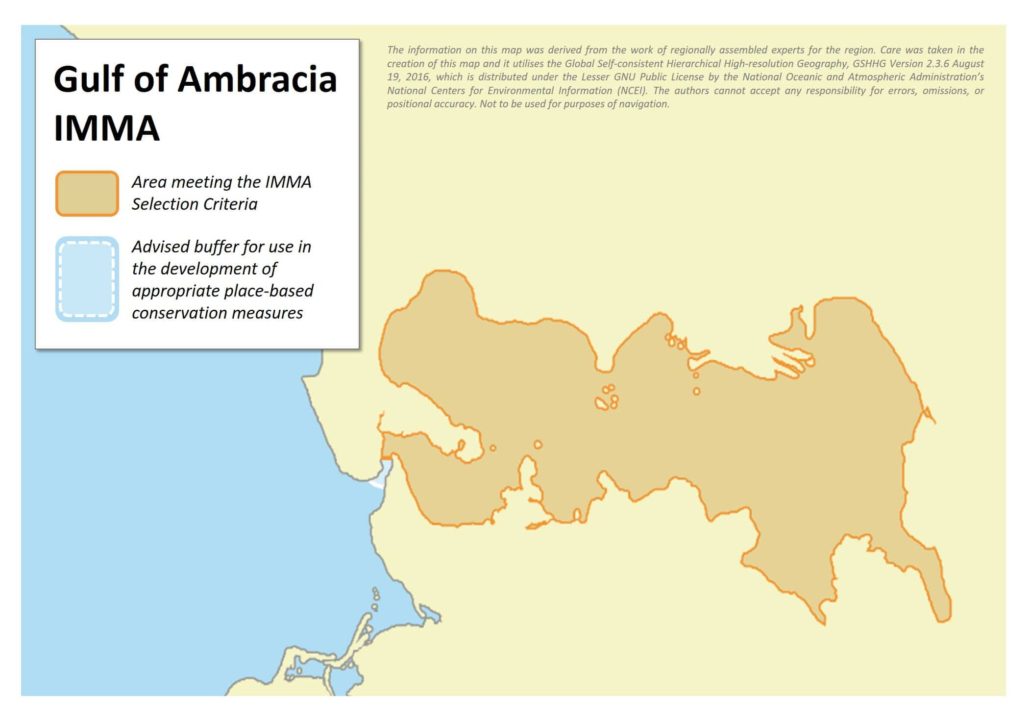Gulf of Ambracia IMMA
Area Size
401 km2
Qualifying Species and Criteria
Common bottlenose dolphin – Tursiops truncatus
Criterion A; B (1); C (1); D (1)
Download brochure
Summary
The Gulf of Ambracia, in Western Greece, hosts one of the highest observed densities of Vulnerable common bottlenose dolphins (Tursiops truncatus) in the Mediterranean Sea. These Ambracian common bottlenose dolphins constitute a geographically distinct and genetically differentiated unit with little demographic exchange. They are also exposed to high levels of pollution, mostly originating from local agricultural activities such as chemical pesticides and fertilizers.
Description of Qualifying Criteria
Criterion A – Species or Population Vulnerability
The Mediterranean subpopulation of common bottlenose dolphin Tursiops truncatus is assessed as Vulnerable in the IUCN Red List of Threatened Species [A2cde] and is based on a suspected population decline of at least 30% over the last 60 years. The bottlenose dolphin is listed in the Appendix II (Mediterranean subpopulation) of the Convention on the Conservation of Migratory Species of Wild Animals (CMS), in the Appendix II (Strictly Protected Fauna Species) of the Convention on the Conservation of European Wildlife and Natural Habitats (Bern Convention), and in the Annexes II and IV of the EU Habitats Directive (Council Directive 92/43/EEC).
Criterion B: Distribution and Abundance
Sub-criterion B1: Small and Resident Populations
The Gulf of Ambracia hosts a small population of bottlenose dolphins that live in the Gulf year-round. The current population estimate of common bottlenose dolphins over a 10-year study was between 130 and 170 animals. Confidence that the true size of the population lies within this range and is therefore high. The estimated trend in population size over the 10 years was a decline of 1.6% per year (however this is not considered significant and there is insufficient power in the data to detect a decline of this magnitude over 10 years). Three individual males first photo-identified in the Gulf of Ambracia, and regularly observed between 2003-2008, were subsequently found in the Inner Ionian Sea Archipelago and in the Gulf of Corinth. However, they have not been recorded again in Ambracian waters. This is consistent with the hypothesis that males are more wide-ranging than females, and they may therefore be the primary vectors of genetic exchange. Such observations indicate some small degree of emigration, but no immigration into the Gulf has been recorded so far.
Criterion C: Key Life Cycle Activities
Sub-criterion C1: Reproductive Areas
Four age categories of bottlenose are recorded within the Gulf of Ambracia including newborns, calves, juveniles and adults, based on visual assessment of sizes in relation to average adult size. During each dolphin sighting, photo-identification studies have determined this Gulf of Ambracia population unit seems to concentrate their breeding season during the summer months, when the sea temperature is higher and the probability of survival of their offspring is greater.
Sub-criterion D1: Distinctiveness
The common bottlenose dolphins of the Gulf of Ambracia are genetically differentiated from the surrounding Mediterranean population. The genetic diversity observed for the Gulf of Ambracia population was the lowest when compared with the rest of populations analysed and with previous studies found in the literature, which suggests that the bottlenose dolphin Ambracian population is highly isolated. The genetic uniqueness of the dolphins of the Gulf of Ambracia, as shown by low mtDNA diversity and the presence of unique haplotypes, demonstrates low connectivity with neighbouring Adriatic Sea and Ionian Sea and could be explained by historical events, and/or low gene flow among populations.
Supporting Information
Bearzi, G., Agazzi, S., Bonizzoni, S., Costa, M., Azzellino, A. 2008. Dolphins in a bottle: abundance, residency patterns and conservation of bottlenose dolphins Tursiops truncatus in the semi-closed eutrophic Amvrakikos Gulf, Greece. Aquatic Conservation: Marine and Freshwater Ecosystems 18(2):130-146.
Bearzi, G., Fortuna, C., Reeves, R. 2012. Tursiops truncatus (Mediterranean subpopulation). The IUCN Red List of Threatened Species 2012: e.T16369383A16369386. http://dx.doi.org/10.2305/IUCN.UK.2012-1.RLTS.T16369383A16369386.en. Downloaded on 22 May 2017.
Bräger, Z., Gonzalvo, J., Agazzi, S., Bearzi, G. 2016. Identification of bottlenose dolphin (Tursiops truncatus) prey using fish scale analysis. Aquatic Mammals 42:63–73.
Gonzalvo, J., Lauriano, G., Hammond, P.S., Viaud-Martinez, K.A., Fossi, M.C., Natoli, A., Marsili, L. 2016. The Gulf of Ambracia’s Common Bottlenose Dolphins, Tursiops truncatus: A Highly Dense and yet Threatened Population. In: Giuseppe Notarbartolo Di Sciara, Michela Podestà and Barbara E. Curry, editors, Advances in Marine Biology, Vol. 75, Oxford: Academic Press, 2016, pp. 259-296.
Gonzalvo, J., Giovos, I., Mazzariol, S. 2015. Prevalence of epidermal conditions in common bottlenose dolphins (Tursiops truncatus) in the Gulf of Ambracia, western Greece. Journal of Experimental Marine Biology and Ecology 463: 32–38.
Gonzalvo, J., Giovos, I., Moutopoulos, D.K. 2015. Fishermen perceptions in support of sustainability of small-scale fisheries and dolphin conservation in two increasingly fragile coastal ecosystems in Western Greece. Aquatic Conservation: Marine and Freshwater Ecosystems 25(1):91-106. doi:10.1002/aqc.2444
Gonzalvo, J., Lauriano, G., Hammond, P.S., Viaud-Martinez, K.A., Fossi, M.C., Natoli, A., Marsili, L. 2016. The Gulf of Ambracia’s Common Bottlenose Dolphins, Tursiops truncatus: A Highly Dense and yet Threatened Population. Advances in Marine Biology 75: Mediterranean Marine Mammal Ecology and Conservation. http://dx.doi.org/10.1016/bs.amb.2016.07.002
Piroddi, C., Moutopoulos, D.K., Gonzalvo, J., Libralato, S. 2016. Ecosystem health of a Mediterranean semi-enclosed embayment (Amvrakikos Gulf, Greece): Assessing changes using a modeling approach, Continental Shelf Research, 121:61-73. http://dx.doi.org/10.1016/j.csr.2015.10.007.
Downloads
Download the full account of the Gulf of Ambracia IMMA using the Fact Sheet button below:
To make a request to download the GIS Layer (shapefile) for the Gulf of Ambracia IMMA please complete the following Contact Form:


